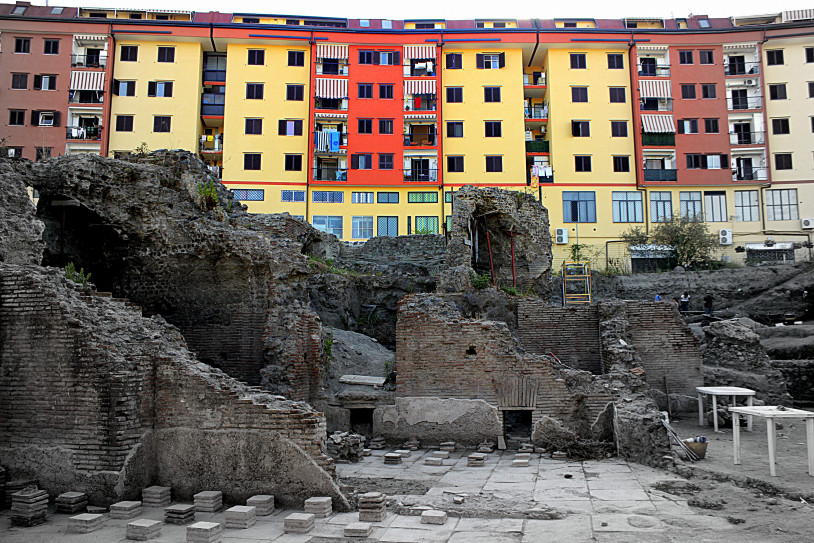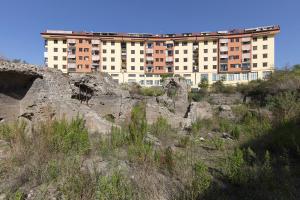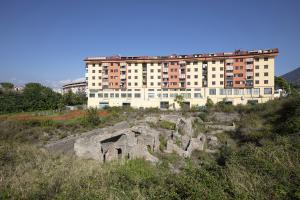
The end of the world went on for two days. It started with an immense column of smoke that rose up from the mountain and then turned into a jagged mass of vast, red-hot claws reaching out into the sky over the Gulf of Naples. After that, the sky itself came crashing down onto the streets, the houses and the taverns, onto the temples and stables, smashing their solid, familiar architecture. In many cases the roofs were weighed down by the ash and collapsed, capturing for centuries the shapes of couples lying in their beds, of horses and dogs caught forever in a final, endless spasm.
In just forty-eight hours, the area around Vesuvius became a terra incognita. What was submerged took the place of a known landscape, of a nature that it was believed had been domesticated. The rural and urban geography of Pompeii, Herculaneum, Stabia, Oplontis and other smaller, gilded bastions of Roman otium was now unrecognisable, swept away with just a little rubble remaining. The wheels of the bureaucracy and civic mechanisms of the capital of the Empire soon began turning. Emperor Titus, the “love and delight of mankind”, prepared the relief effort. And he drafted the first rules for the revival: no human abuse was to be allowed in this land already devastated by nature. There was to be no place for building speculation. Strict laws, applied by a commission of former consuls constituted by drawing lots (Suetonius, Life of Titus, 8), would govern the reconstruction.
The town of Pollena Trocchia, on the western edge of Vesuvius, now stands on one of the sites that is less known but that was hardest hit by the eruption. From one apocalypse to another: in 1988, at the height of the reconstruction after the disastrous earthquake of 1980, work started on building a new group of apartment blocks. As in Naples and in many other areas of Campania, construction had become the new focal point for the local mafia, the Camorra.

Earthquake in Irpinia, 1980. Photo by Antonietta De Lillo
Extract from the Final Report and Proposal Report of the Parliamentary Commission of Inquiry into the implementation of operations to reconstruct and develop the territories of Basilicata and Campania affected by the earthquakes of November 1980 and February 1981, Approved on 27 January 1991 (p. 520)
“It has been noticed that the infiltration of criminal organisations, and of the Camorra in particular, can no longer be explained by the methods adopted in the past, as in the 1970s, when we were faced with criminal organisations that did not go beyond demanding bribes, carrying out extortion activities, demanding to be used for protection of the construction site or industrial activity, or for some minor works (in particular earth moving), establishing their influence within fairly limited margins. With these post-earthquake operations we are witnessing the emergence, as protagonists, of companies owned by Camorra families, or infiltrated by or in collusion with Camorra members [...] It is also important to point out that it is very hard to distinguish between companies run by members of the Camorra and those that simply accept injections of money, taking on the Camorra as financiers, in order to assist in money laundering. It is difficult to establish the subjective responsibility of the entrepreneur who allows the entry of new partners and one who makes use of the contribution of a mere lender. Here the corrupt and the corrupter are very closely intertwined; it is difficult to say no to a request from a criminal organisation for the “courtesy” of putting money into a business. It has also been noticed that, upon arrival in the area, large companies that also work in other parts of Italy and that have obtained contracts for the earthquake area, have immediately expressed their intention to come to terms. Indeed, the bigger, richer and more important such companies are from a financial point of view, the more they are willing to “come to terms”, because the costs involved are relatively bearable, and can be considered as only marginal.”
In a situation like this, any concern for archaeological heritage counts for nothing. The cooperatives involved in the reconstruction of Pollena Trocchia are no exception. The edicts promulgated by Titus prevented the speculators of AD 79 from getting around the restrictions, but in the twentieth century, buildings went up without too many questions being asked, without any great desire to find or preserve what was around and beneath the ground.
And yet the fact that something was down there was already well known. In the early twentieth century, an amateur archaeologist, Count Ambrogino Caracciolo di Torchiarolo – one of the many aristocrats of that time who studied antiquity – had already explored the subsoil in Pollena, finding some fragments that had prompted him to call for intervention by the Soprintendenza.
And plenty of discoveries were made after that.
An extract from the Corriere della Sera, 17 May 1964, page 8
“A first-century Dionysus emerges from volcanic sand”
“[...] As the shovels and pickaxes gradually break up and move the layers of lava and soil, the remains of a sumptuous villa emerge. This is one of many built in the area by wise men who spent long, agreeable periods of rest in the countryside amid bountiful orchards and gardens, with the grace of sweet maidens and amphorae full of purest wine [...] The precise point is known as the “cupa San Gennariello” (“cupa” is a dialectal name for a narrow country road between two high walls that mean it is always shaded). Here there is the farm of a winemaker, Vincenzo Di Sarno, who also owns a sand quarry. The workers had already noticed that their iron tools no longer sank into the ground but struck against something very hard. [...] A wonderful sculpture began to appear, like a white flower: a vigorous man holding a bunch of grapes in his left hand. Astonished and caught by the anxiety that every archaeologist knows well, those present stood motionless.”
Extract from Girolamo De Simone. (2008). Il territorio nord-vesuviano e un sito dimenticato di Pollena Trocchia. Cronache Ercolanesi. 38. 329-349.
“The Dionysus is of the well-known, widely spread type known as the Woburn Abbey. Our statue was found in several fragments and the head appears very corroded, with the nose, the lips and part of the eyes missing. A smooth taenia ribbon with two lateral ribbings holds the hair decorated at the nape, and two loose braids fall on the neck. The head is crowned with leaves and bunches of grapes, with a chiaroscuro effect created by a drill. [...] The face is a regular rounded oval, the full upper eyelids are slightly lowered and the iris is marked by a circle; the inner corner is deepened with a drill hole and an incision around the lacus lacrimalis. The face is strictly classical in style, in an oval with very rounded outlines. There is a degree of contrast between the sharp treatment of the masses and of the hair and the rendering of the bunches of grapes, which are dominated by contrasts. These elements suggest that the statue dates from at least the late Hadrianic period.”
NOTE: the reign of Emperor Hadrian lasted approximately from AD 117 to 138. During this period, Greek classicism, taken up by Augustus and surpassed by the time of Trajan, made its return to official art, but with a new spirit that was more nostalgic, romantic, and intellectually refined.
In February 1988, in the Masseria De Carolis area, the cooperatives’ mechanical shovels accidentally sank their teeth into a wall that shouldn’t have been there, beneath several metres of earth, dust and ash. It was the wall of the warehouse of a large country villa dating from the second century AD. This discovery brought with it an idea that might solve a little Neapolitan mystery, which appears in historical chronicles but which has never been fully clarified: this might be the site, though it has never identified with certainty, from which the workers involved in building the San Carlo in Naples extracted 18,000 bricks in 1749. The hypothesis was however quickly refuted. Incredibly, work resumed.
Over the following twenty years the entire area became an unauthorised dump for building materials. What had temporarily surfaced from the earth was once again covered over. All around rose the multicoloured facades of new buildings, oblivious and indifferent.

Excavations of Pollena Trocchia. (c) manalahmadkhan, via Flickr
The situation remained like this until 2006, when work to salvage and excavate the site started up again. Only then was it discovered that, beneath all the refuse, lay what is still the oldest known archaeological site in the Vesuvius area dating from the period after the eruption of 79 AD: one of the first constructions to have its foundations buried in the ashes deposited by Vesuvius. The villa had a vast complex of baths, of which ten rooms have been excavated.
On a number of levels, traces were found of the centuries that separate the destruction of Pompeii and its surroundings from the fall of the Roman Empire in the fifth century. The villa, which was built shortly after the eruption, shows how the area came back to life and then gradually declined.
At a certain point in their history, the baths at Pollena Trocchia underwent an ominous, terrible transformation, probably as unexpected as the eruption that had come before its construction. This place, which had been devoted to pleasure, social life and wellbeing, became a site for the burial of infants and adolescents. Dozens of little graves in the bare earth, without no containers or sarcophagi to protect the bodies, were unearthed. Immediately nearby are the remains of pagan funeral rites related to food. Many of the skeletons unearthed bear the signs of serious infections, which suggests that they were the victims of one of the numerous epidemics that ravaged the last period of the Empire. Many of those bones were exhumed and buried a number of times.
Extract from Girolamo F. De Simone, Monica Lubrano, Marielva Torino, Alessandra De Luca, Annamaria Perrotta, Claudio Scarpati, “La villa con Terme di Pollena Trocchia in località Masseria De Carolis: architettura, abitanti, eruzioni”
One of the most plausible hypotheses is that these were small burials: when the area lost its function and materials were found elsewhere, it is likely that older burials were unearthed and, in line with the religious beliefs regarding the world of the dead, it was decided to give a proper burial to the bones that had been disturbed. [...] It should be remembered that children who died were subject to a so-called “funeral discrimination”: an analysis of the type of funeral afforded to these members of the community offers some very interesting insights that help us understand the evolution of social systems and ritual beliefs involved in the very delicate stages of life before the individual was introduced into society. The fact that infants were excluded from the spaces used by the community for burials of adults does not, however, mean that they were denied the right of burial, and this is shown by the increasingly frequent unearthing of child burials in residential settings.
Human residues found in the excavations of Pollena Trocchia. Image taken from: Girolamo De Simone et al. The villa with baths of Pollena trocchia in the locality masseria De Carolis: architecture, inhabitants, eruptions
Bonds were broken, and rituals were transformed to adapt to the crisis: buildings were constructed where they should not have been, and burials made where they would never have been imagined. Houses, the land and the countryside become places that were at once familiar and unknown. It was unheimlich, Freud’s “uncanny”: the feeling of terror and repulsion that one feels when faced with something known that temporarily appears as deformed, grotesque, out of joint. In places like this, it is not surprising that legends of ghosts and restless spirits have always abounded.
A new eruption destroyed the settlement of Pollena Trocchia in AD 472, burying the baths and their children until 1988.
Extract from the Chronicles by Marcellinus Comes, sixth century:
“472 Marciani et Festi”.
1) Vesuvianus mons Campaniae torridus intestinis ignibus aestuans exsusta evomuit viscera nocturnis que in die tenebris incumbentibus omnem Europae faciem minuto con texit pulvere. Huius metuendi memoriam cineris Byzantii annue celebrant VIII idus Novemb.
“In AD 472 under the consulate of Marcianus and Festus”
1) Vesuvius, a burning mountain in Campania, seething with internal fires, vomited forth searing bowels, the darkness of night looming over the day, covering the whole surface of Europe in fine dust. They remember this dust every year on 6 November in Byzantium.
Four years later, the Western Roman Empire ceased to exist. It is not hard to imagine what the inhabitants of ancient Pollena must have felt in that period.
“We will not stay.
The bay-trees in our country are all wither’d
And meteors fright the fixed stars of heaven;
The pale-faced moon looks bloody on the earth
And lean-look’d prophets whisper fearful change;
Rich men look sad and ruffians dance and leap,
The one in fear to lose what they enjoy,
The other to enjoy by rage and war.”
William Shakespeare, Richard II, Act 2, Scene 4.












